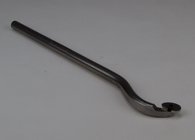I am planning to order a T. Bosch stabilizer/system and some tooling. I am considering including some of his hollowing teardrop scrapers in the order. At the moment I have 5/8" set (straight, bent, & extreme bend) and a straight 3/4" in my cart. I am leaning toward the negative rake grind.
From those of you that use them, feedback and insights on their performance would be appreciated.

From those of you that use them, feedback and insights on their performance would be appreciated.

